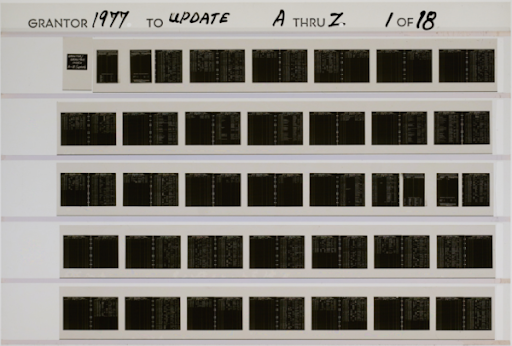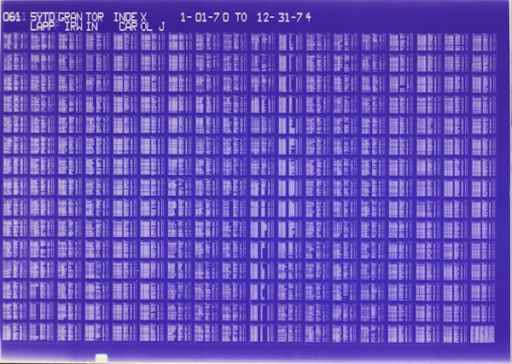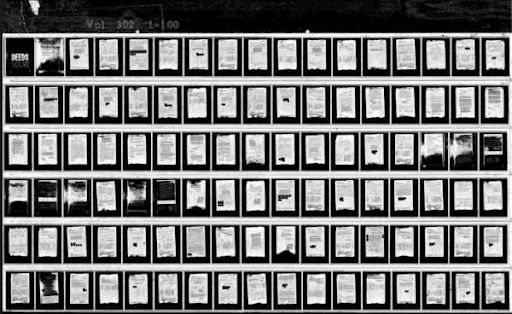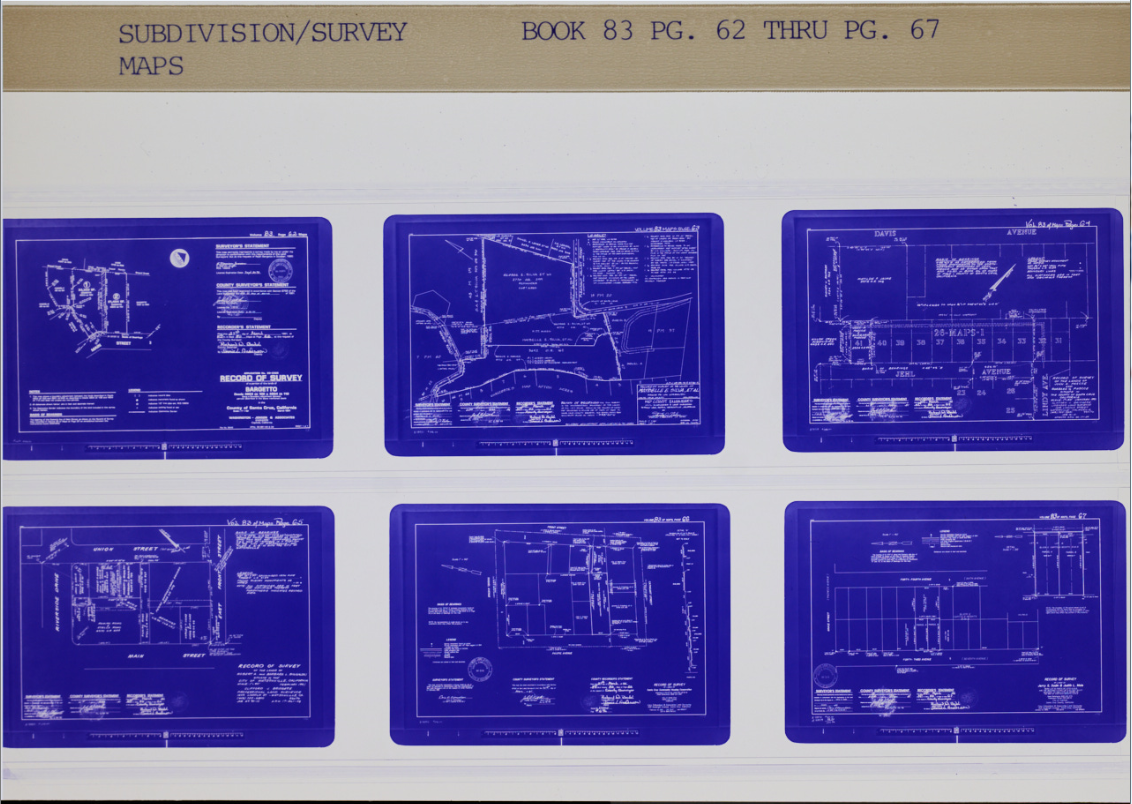Microfiche comes in multiple formats and styles, and if you’re looking into having your microfiche scanned it’s important to know which type you have.
Here we’ll describe what microfiche is in a general sense, and then illustrate the variations that you may come across in your own collection.
What Is Microfiche?
Microfiche, from French for “small card,” is made of a flat sheet of film usually with a polyester base on which multiple pages are captured in reduced size. The standard size is 105mm x 148mm (about 4 inches x 6 inches).
It’s a record format that stores micro-reproductions of images on film. These images are captured by photographing the original document and reproducing the images at a reduced size. By creating microfiche from original documents, large quantities of images and vast amounts of data can be kept in a relatively small space.
This article will give you the details on the various types of fiche so you know what you’re working with and how to describe it when you work with a scanning partner.
Jacket Microfiche
16mm Jacket Microfiche

Fiche Size
4” x 6”
Image Quantity
5 rows (channels) x 12 columns
60 images when full
Image Size
Typically office-sized documents (8.5×11”) and smaller items such as checks, receipts, and so on.
Reduction Ratio
The magnification level that the microfiche was originally photographed. In other words, it’s the number of times that the image of the original record is reduced to fit on the microfiche.
16mm jacket fiche is typically 24x reduction ratio. So if you’re looking at a sheet of jacket fiche with standard office docs, such as student records, the image you’re seeing is 24 times smaller than if you were holding the actual document.
Image Layout
Microfiche images should be right reading, but that’s not always the case. Oftentimes the images get flipped around and end up in the following orientations:
- Non-right reading images
- Mirrored images
- Upside down individual images
- Upside down channels
- Upside down and mirrored images
- Framing order
For more detail on these orientations, head to our How Much Does Microfiche Scanning Cost? article and scroll to the “Image Layout” section – there are some toggles that give you plenty of additional info!
Use Cases (Industry / Department)
16mm microfiche is found in all industries and departments: in building departments you’ll find plans and permits on fiche; in education, you’ll find student records and transcripts; In law enforcement, police reports and court files; in insurance and finance, member statements.
Organizations of all types use office-sized documents, so 16mm images can be found in almost any organization that has microfilm.
Scan Cost
$0.75 – $1.25/sheet is a great place to start.
Much of the price will depend on how many microfiche sheets you’re getting scanned and the indexing (digital naming) of the files. And if you have any of the special layouts, fixing them so that all your images are right-reading could be an increased cost.
Make sure you communicate the specifics of your microfiche to your scanning partner to get an accurate quote!
35mm Jacket Microfiche

Fiche Size
4” x 6”
Image Quantity
2 rows (channels) x 3 columns
6 images when full
Image Size
Typically oversized or large format documents such as engineering drawings and deed books.
Reduction Ratio
The magnification level that the microfilm was originally photographed. In other words, it’s the number of times that the image of the original record is reduced to fit on the microfiche.
35mm jacket fiche is typically 9-17x reduction ratio. If you’re looking at a sheet of fiche containing oversize docs, like deed book images or engineering drawings, the image you’re seeing is 9-17 times smaller than if you were holding the actual document.
Image Layout
The majority of 35mm microfiche will have one image per frame, meaning it’s a single document. However, you might run across a 35mm fiche frame that has multiple smaller images in it. If this is the case, you can either receive the digital image as that single frame and just zoom in to see the different documents, or you can have the individual documents cropped, or framed, so that they represent their own page.
Use Cases (Industry / Department)
35mm microfiche is found in many industries. Building/planning departments have a lot of 35mm fiche with plans, blueprints, and drawings, and County Recorders or Clerks could have their Official Records and Deed Books on 35mm fiche.
Scan Cost
$0.75 – $1.25/sheet is a great place to start.
Much of the price will depend on how many sheets you’re getting scanned and the indexing (digital naming) of the files. If you have to crop images within the frames, that could increase the price, too.
Make sure you communicate the specifics of your microfiche to your scanning partner to get an accurate quote!
COM Microfiche

Fiche Size
105mm x 148mm
(roughly 4” x 6”)
Image Quantity
15 rows (channels) x 18 columns
270 images when full (some up to 300 images)
Some can have ~400 images if they’re at a higher reduction ratio
Image Size
Typically oversized or large format documents such as engineering drawings and deed books.
Reduction Ratio
The magnification level of the images on the microfiche – the number of times that the image of the original record is reduced to fit on the microfiche.
COM fiche is typically 42x reduction ratio. So if you’re looking at COM sheet, the image you’re seeing is 42 times smaller than if you were holding the document.
Image Layout
Typically, fiche images are read left-to-right, top-to-bottom, but in some cases the framing order is in a different sequence. In these cases, we can adjust the framing so that your digital file reads in the proper order.
In most cases with COM fiche, there’s an index frame at the bottom right of the sheet that indicates the frame locations of the content. If you’re looking for “John Smith” and the index says “B13,” you’d know to find frame B13 on the fiche and you’d have the correct info.
Use Cases (Industry / Department)
COM microfiche is typically filled with finance or similar data, such as bank member statements. However, organizations of all types use COM fiche
Scan Cost
$3 – $5/sheet is a good ballpark range to start.
Much of the price will depend on how many microfiche sheets you’re getting scanned and the indexing (digital naming) of the files.
Other Microfiche
Oversize
Oversize microfiche is so named because it’s larger than the standard size of most fiche. Sizes can vary, but a common oversize fiche is in the 5″ x 8″ area and will have more columns than a standard jacket fiche.

Combo 16/35mm Jacket Microfiche
Combo 16/35mm jacket fiche are made of sleeves that hold strips of both 16mm and 35mm roll microfilm stored in a clear Mylar jacket. Combo jackets are typically 4 inches x 6 inches and hold a varying number of strips of film, depending on the contents. A title strip area across the top of the jacket normally has the microfiche’s title and indicates its contents.
Step & Repeat Microfiche
Step and Repeat fiche are filmed on a specialized camera, which is a planetary-style (overhead) camera that films the images directly to the fiche sheet (as opposed to creating a roll of microfilm then cutting the film into strips, as in jacket fiche). Normally seen in 24x or 48x reduction ratios, a step and repeat fiche has up to 96 frames per sheet.
105mm Microfiche
Although most microfiche are on sheets that measure 105mm x 148mm, when specifically referred to as a 105mm fiche, the term means a single image that takes up the entire fiche sheet. This format was typically used for large format engineering drawings and maps. Fairly rare, these types of fiche are slow to scan and require special microfiche scanners that are not always readily available.
Vesicular Microfiche
A polyester-based duplicating film used to make low-cost distribution copies. Vesicular film is created using a thermal process and is not stable for long-term retention. Vesicular fiche typically have a light-blue color and are known to be fairly scratch-resistant.
Next Steps
Reach out to us today! Click the “Get Your Quote” button below, fill out the form, and we’ll quickly reply to you to discuss your project.
Further Reading
Microfiche Scanning: 6 Frequently Asked Questions
Do you have questions about microfiche scanning? Here are our 6 most frequently asked questions that we answer for you, including “which type of microfiche do I have?” and “what does the microfiche scanning process look like?”
The BMI Microfiche Scanning Process
Do you have microfiche records you want to scan and are curious about how it’s done? Our 11-step microfiche scanning process will show you how we convert your physical microfiche collection to digital files, covering tracking, preparation, scanning, digital delivery, and more.
3 Mistakes That Can Derail Your Microfiche Scanning Project
When you decide to digitize your microfiche collection, the last thing you want to happen is it gets derailed by something that could’ve been avoided. Check out these 3 mistakes to avoid in your microfiche scanning project.

